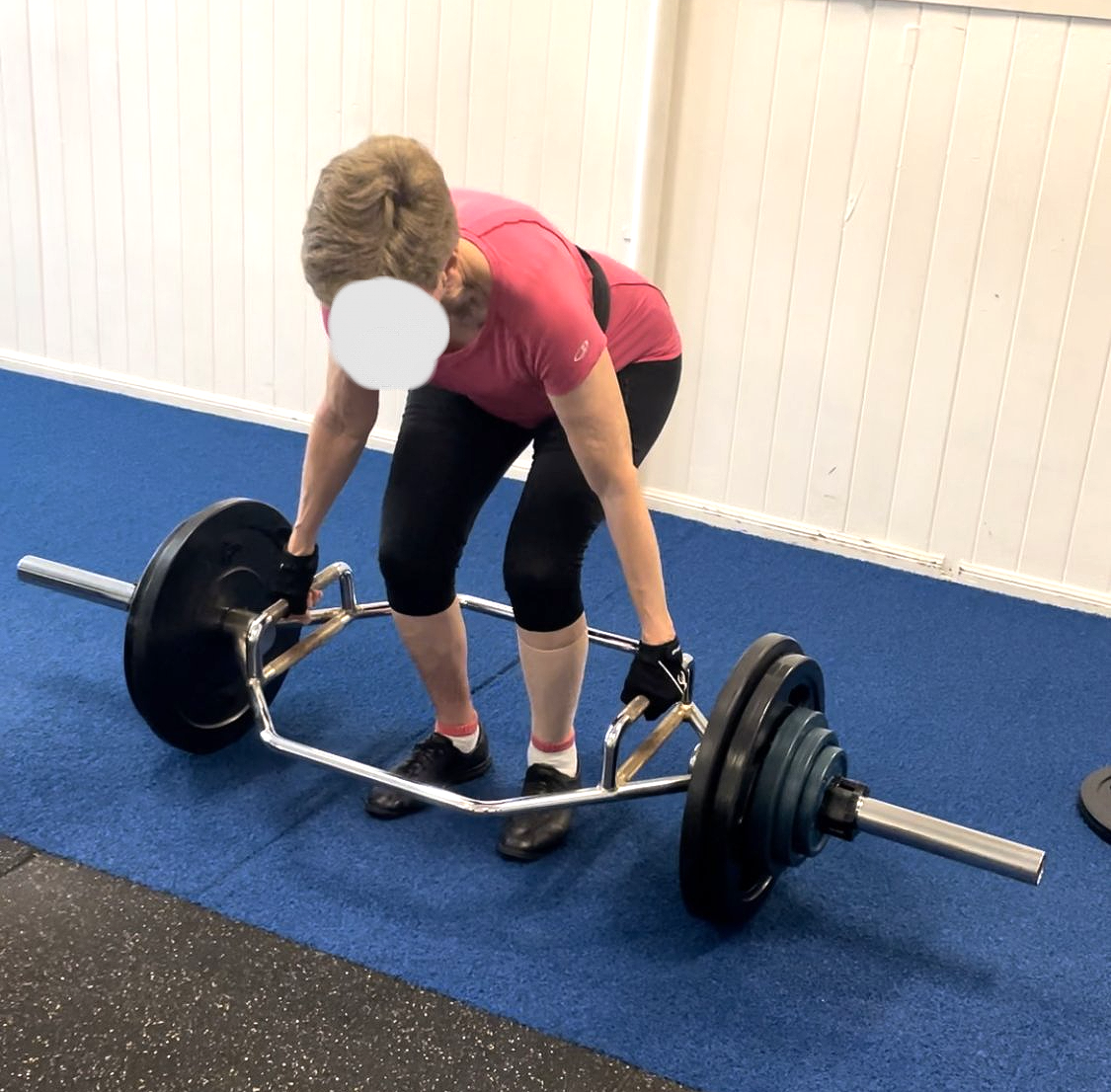How to progressively lift heavier weights with older adults?
Osteoporosis guidelines recommend lifting heavy weights at 80-85% intensity.
That means, 80-85% of whatever weight you could lift for 1 repetition only (and not 2 repetitions - this is called your 1 rep max or 1 RM), which should be able to lift 5-6 times. So say you can lift 50kg once but not twice; you should theoretically be able to lift 40-42.5kg for 5-6 repetitions. Commonly you would do this in 4-5 sets. The reason for this is because you are not lifting the weight all that many times - only 5 in a set- so you need more sets to get more total workload done. This is how normal strength training is often completed, and seems to be particularly important for bone health.
I have been running bone density classes for 2 and a half years and have had some great results with women being able to lift nearly 1.5x body weight (though a number of these women have been training for >5 years at another clinic before starting with me). A couple of people have reached out to me to ask how they managed to get there, so I thought I’d write a blog with a bit of a crash course detailing how I personally manage our progressions.
Note, this is not intended to be used as medical advice or as a guide, it is just detailing how these ladies in particular achieved this.
Older adults with limited lifting experience (no training before 60 years old for most of them) with osteoporosis have specific requirements and so I progress them pretty carefully and slowly. You technically shouldn’t be training on your own if you have osteoporosis as it is considered high risk, but obviously it is not always possible for everyone to have access to supervised weight lifting sessions.
Something to bear in mind is that often these ladies have an increased curve in their upper back (kyphosis) which is a result of their osteoporosis, and they may have limited mobility in their hips and knees (or have joint replacements), so the way they lift may look a bit different to how you may have been taught is technically 'correct'. For me, it is about being mindful of what these women have done up until this point to determine whether their body is likely to have adapted enough to handle an increase in weight, even if done using a slightly different than “ideal” technique, using the principle of adaptation which states the human body is able to adapt to tolerate the loads placed upon it. Generally this means progressing a fair bit slower than I would in a different population.

How I begin:
To begin with, I start first with teaching how to hip hinge as a base exercise. We usually do this in our initial 1:1 consultation.
Next we use a dumbbell and practice hip hinging, usually a 10kg and build it up gradually over a few weeks. Usually I would do this with something like 4 sets of 10 as it is a light weight and more repetitions are helpful to practice the movement pattern. When they can lift the 20kg dumbbell, we progress to the barbell as the lightest option is 25kg (a 15kg bar and 2x5kg plates).
As soon as the client is comfortable lifting the bar I drop the reps back to 4 sets of 5-8 reps, as the weight is now relatively heavy, and they are unlikely to be able to lift it as many times. We practice 25kg then gradually up the weight 2.5kg at a time. How fast this happeneds depends on the client.
When they can lift 30kg, I introduce the trap bar, as the lightest this can go at my gym 34kg. We will practice 4x5-8 reps in the trap bar at this weight and gradually increase from there.
We will alternate between trap bar and regular bar each session, and usually have a third day with a different exercise option in it.
I base progressions in weight on:
- Body weight: lighter people I start lighter and progress more slowly as how much you can lift is relative to your body weight.
- Training experience. People who havent lifted before I progress much more slowly.
Age, but this is not as important and is relative to training age, but I will be a bit more willing to introduce the barbell and trap bar to people under 60 without using the dumbbell first, though it really depends. New Paragraph
Once my ladies can happily complete reps in the trap bar (the hexagonal bar in the top photo - its a bit easier technically as the weight is either side of you instead of in front of you and the handles are higher up on your leg) and on the regular barbell, I start to play around with the sets and reps.
Bear in mind that if you do less reps the idea is that you should be able to do more weight as you don’t have to do it as many times. The goal when doing 5-6 reps in my classes is to be lifting at an intensity where you could physically only do 2-3 more reps after you’ve done your programmed number (something which is pretty hard to get near if you have not trained much in your life!).
I will start the reps in the first proper training block with the barbell with 5 sets of 6 -8reps, for 6 weeks. In this time, we often will gradually just add a bit of weight each set.
For example, they may warm up for 2 sets of 6 at 30kg then 35kg. Their 5 working sets might look like: 35, 35, 37.5, 37.5, 40kg.
I find when people are less familiar with lifting heavy weights, this way works better, as they are getting used to the feeling of the heavy weight with each set.
I use higher reps still because often people are not lifting anywhere near their true max - it is a bit pointless to do only 5 reps of a weight you feel you could have done for 10.
Once my ladies have completed a 6 week training block of steady linear increases in weight, I will play around with the reps a bit more.
I will do something like 5 sets of 6, 6, 5, 5, 4 reps, so that we can bump the weight up even more on the last set, so that they get used to the feeling of the heavier weight again. As it gets heavier, i really re-enforce the importance of rest breaks: a minimum of 2 minutes between sets.
I may then do something similar the next block but drop the reps even lower, for e.g. 5 sets of 5, 5, 4, 4, 2, once for the same purpose of introducing heavy weight on that final set.
Once it has been a consistent 18 weeks or so of training, I will swap the order of the lifts around to try a top set of 3 at the start, then lighter back off sets. This is only possible for the women coming who are pretty confident with lifting heavy and we both have a fairly good idea of what they can do from their last training block.
So we will do something like a top set of 1x3 and back off sets of 3x5. This requires more warm up sets as we are starting heavy so need more time to build up there.
For example, we might do a warm up set of 5 at 40kg, 4 at 45kg, 2 at 50kg, then a top set of 3 at 55kg, with 3x5 back off sets at 47.5kg. I work these numbers out with my ladies on the day depending on how they feel, how fast the weight moves, and what they have done in the past.
After this block we might then build on it again and do a top set of 1, followed by a back off set of 3, and 2-3 back off sets of 5 reps. This is a great way to round out 30 weeks of training (5x 6 week training blocks) and also gives a bit of an indication of what their 1RM lifting ability is to base their next blocks on when we go back to the beginning again.
Note that I avoid ever going to a true 1RM with this population, but what they can lift for 1 repetition will still give a good idea of what they are capable of for 3-5 reps as a general calculation (5 reps should be approximately 15% less than what you can do for 1 rep, ish).
I hope this helped to provide some idea of how you can progress your weights as someone who may not be super familiar with strength training!

